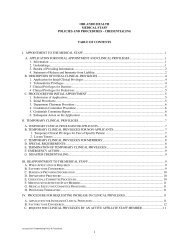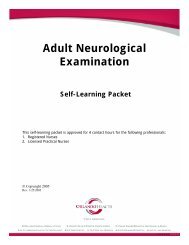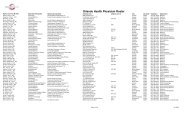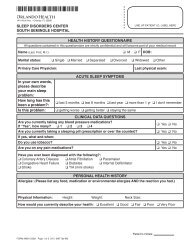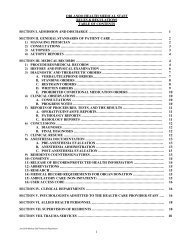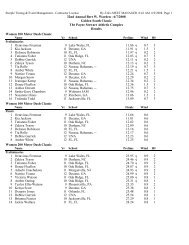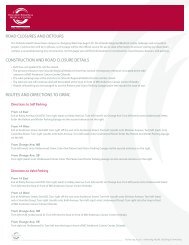Introduction to CV Pharmacology - Orlando Health
Introduction to CV Pharmacology - Orlando Health
Introduction to CV Pharmacology - Orlando Health
Create successful ePaper yourself
Turn your PDF publications into a flip-book with our unique Google optimized e-Paper software.
<strong>CV</strong> <strong>Pharmacology</strong><br />
AP Phase Response ECG Waveform<br />
Phase 0<br />
Rapid<br />
Depolarization<br />
Phase 1<br />
Peak Phase<br />
Phase 2<br />
Plateau Phase<br />
Phase 3<br />
Beginning<br />
Repolarization<br />
Phase<br />
Phase 4<br />
Resting Phase<br />
The initial upswing indicates rapid depolarization<br />
by the influx of sodium in<strong>to</strong> the myocardial cell.<br />
Potassium begins exiting cells.<br />
This peak reflects the brief period that sodium<br />
channels close.<br />
Calcium channels open for a slow influx of calcium<br />
ions <strong>to</strong> prolong depolarization.<br />
Calcium plays a key role in myocardial contraction.<br />
This rapid downswing marks the closure of sodium<br />
and calcium channels <strong>to</strong> prevent any further entry<br />
of sodium or calcium in<strong>to</strong> the cell.<br />
Potassium begins <strong>to</strong> move back in<strong>to</strong> the cell.<br />
The cell is now ready for another depolarization<br />
stimulus.<br />
QRS<br />
Absolute Refrac<strong>to</strong>ry Period<br />
QRS<br />
Absolute Refrac<strong>to</strong>ry Period<br />
QRS<br />
Absolute Refrac<strong>to</strong>ry Period<br />
QRS and first half of T wave<br />
Absolute refrac<strong>to</strong>ry period until<br />
midpoint of T wave, then becomes<br />
relative refrac<strong>to</strong>ry period, the last<br />
half of T-wave.<br />
Absolute Refrac<strong>to</strong>ry Period<br />
Relative Refrac<strong>to</strong>ry Period<br />
Last half of T wave as it returns <strong>to</strong><br />
isoelectric line<br />
Relative Refrac<strong>to</strong>ry Period<br />
Keep in mind the ECG only represents electrical heart activity, not the actual contraction<br />
of the heart.<br />
Based on these previously mentioned principles, antidysrhythmic drugs are designed <strong>to</strong> modify<br />
the movement of ions in the various AP phases by altering the electrophysiology of the cardiac<br />
cell. Based on this principle, antidysrhythmics are classified based on their mechanisms of<br />
action and effects on the action potential.<br />
Currently there are four main classes of antidysrhythmics. The classification system (Vaughan-<br />
Williams) can assist you in recalling the actions and adverse effects.<br />
<br />
<br />
<br />
<br />
Class I - - Block sodium ion channel<br />
o<br />
o<br />
o<br />
Class Ia<br />
Class Ib<br />
Class Ic<br />
Class II (beta-blockers) - Block beta recep<strong>to</strong>rs<br />
Class III - Block potassium ion channels<br />
Class IV (calcium channel blockers) - Block calcium ion channels<br />
In general, drugs within the same class are similar in action and adverse effects and some drugs<br />
may have properties of more than one class category. (Example: amiodarone, sotalol). It is also<br />
important <strong>to</strong> note that all antidysrhythmics have the potential (some worse than others) <strong>to</strong><br />
2010 <strong>Orlando</strong> <strong>Health</strong> Education & Development 11




